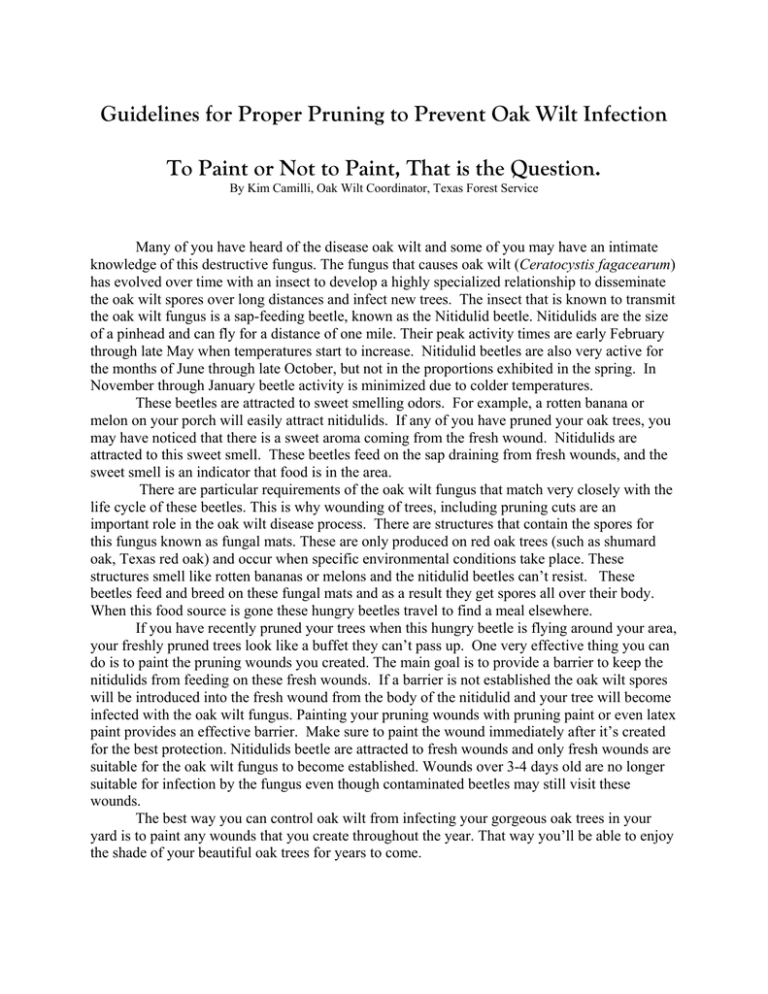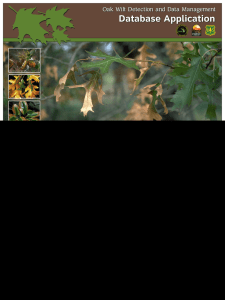Guidelines for Proper Pruning to Prevent Oak Wilt Infection
advertisement

Guidelines for Proper Pruning to Prevent Oak Wilt Infection To Paint or Not to Paint, That is the Question. By Kim Camilli, Oak Wilt Coordinator, Texas Forest Service Many of you have heard of the disease oak wilt and some of you may have an intimate knowledge of this destructive fungus. The fungus that causes oak wilt (Ceratocystis fagacearum) has evolved over time with an insect to develop a highly specialized relationship to disseminate the oak wilt spores over long distances and infect new trees. The insect that is known to transmit the oak wilt fungus is a sap-feeding beetle, known as the Nitidulid beetle. Nitidulids are the size of a pinhead and can fly for a distance of one mile. Their peak activity times are early February through late May when temperatures start to increase. Nitidulid beetles are also very active for the months of June through late October, but not in the proportions exhibited in the spring. In November through January beetle activity is minimized due to colder temperatures. These beetles are attracted to sweet smelling odors. For example, a rotten banana or melon on your porch will easily attract nitidulids. If any of you have pruned your oak trees, you may have noticed that there is a sweet aroma coming from the fresh wound. Nitidulids are attracted to this sweet smell. These beetles feed on the sap draining from fresh wounds, and the sweet smell is an indicator that food is in the area. There are particular requirements of the oak wilt fungus that match very closely with the life cycle of these beetles. This is why wounding of trees, including pruning cuts are an important role in the oak wilt disease process. There are structures that contain the spores for this fungus known as fungal mats. These are only produced on red oak trees (such as shumard oak, Texas red oak) and occur when specific environmental conditions take place. These structures smell like rotten bananas or melons and the nitidulid beetles can’t resist. These beetles feed and breed on these fungal mats and as a result they get spores all over their body. When this food source is gone these hungry beetles travel to find a meal elsewhere. If you have recently pruned your trees when this hungry beetle is flying around your area, your freshly pruned trees look like a buffet they can’t pass up. One very effective thing you can do is to paint the pruning wounds you created. The main goal is to provide a barrier to keep the nitidulids from feeding on these fresh wounds. If a barrier is not established the oak wilt spores will be introduced into the fresh wound from the body of the nitidulid and your tree will become infected with the oak wilt fungus. Painting your pruning wounds with pruning paint or even latex paint provides an effective barrier. Make sure to paint the wound immediately after it’s created for the best protection. Nitidulids beetle are attracted to fresh wounds and only fresh wounds are suitable for the oak wilt fungus to become established. Wounds over 3-4 days old are no longer suitable for infection by the fungus even though contaminated beetles may still visit these wounds. The best way you can control oak wilt from infecting your gorgeous oak trees in your yard is to paint any wounds that you create throughout the year. That way you’ll be able to enjoy the shade of your beautiful oak trees for years to come.



